Case Reports
Patients with keratoconus are most commonly fitted with rigid gas permeable (RGP) contact lenses in order to correct the myopic astigmatism that is usually present. Whilst RGP lenses are generally very successful in keratoconic patients, there are significant numbers who experience discomfort and reduced wearing times – often due to a compromised lens fit.
Other contact lens fitting options in keratoconus include scleral lenses, hybrid lens designs, soft toric lenses, speciality soft lenses and piggy-back lens systems. Piggy-back lens systems usually consist of an RGP lens fitted on top of a soft lens. Since the soft lens covers the entire cornea, it provides a ‘cushioning’ effect from the overlying rigid lens. This improves comfort and lens centration as well as protecting the corneal cone apex in keratoconus. This report describes silicone hydrogel / RGP lens combinations in two keratoconic patients; one patient with mild keratoconus and one patient with advanced keratoconus.
Case 1 (Mild keratoconus)
A 54 year old female with bilateral keratoconus was initially referred after being fitted with RGP lenses elsewhere. She complained that RGP lenses were uncomfortable and that she experienced reduced wear times and ocular redness. She was initially refitted with a low Dk hybrid lens design (the only hybrid lens design available at that time) and she wore the lenses relatively successfully for several years until she again started to experience discomfort and ocular redness. In addition she had developed corneal vascularisation due to the low oxygen transmissibility of the hybrid lenses and the long wear times required.
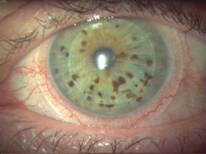 |
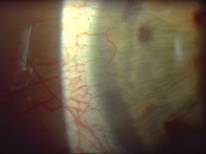 |
| Figure 1. Low Dk hybrid lens (left) and corneal vascularisation (right) |
Refraction revealed
OD –8.00/-2.00 x 160 6/9
OS –10.00DS 6/9
The refraction was carried out immediately on removing the hybrid lenses and the true level of astigmatism was thought to have been masked due to corneal moulding.
After discussion with the patient it was decided to try a piggy-back lens system. In view of the corneal vascularisation present, a hyper Dk piggy-back lens system was selected. The carrier lens chosen was a Focus Night & Day lens whilst the RGP lens chosen was a Menicon Z alpha lens. A +3.00D Night & Day lens was used as the carrier lens in this case. Keratometry readings were taken over the silicone hydrogel carrier lenses and these readings were used as a basis for selecting the BOZR of the RGP lenses. A hydrogen peroxide care system was recommended since this could be used for both the hydrogel and RGP lenses.
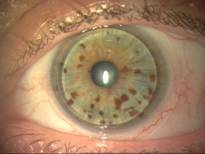 |
| Figure 2. Hyper Dk piggy-back lens system |
Visual acuity was found to be 6/6 in both eyes and the patient was delighted with the comfort, improved vision, longer wear times and the decreased ocular redness. In addition the corneal vascularisation reduced. This patient has elected to stay with the piggy-back lens system even though she could be refitted with a high Dk version of her original hybrid lens.
Case 2 (Advanced keratoconus)
A 46 year old male with bilateral keratoconus was initially referred for a refit with RGP lenses as his existing lenses had become uncomfortable and his wear time had reduced. He also complained that his lenses would occasionally decentre onto the sclera and this had even occurred whilst he was driving. He complained of sensitivity to light making slit lamp biomicroscopy difficult. Slit lamp findings showed the classic signs of keratoconus (Munsons sign, corneal thinning, central scarring). The condition was more advanced in the left eye.
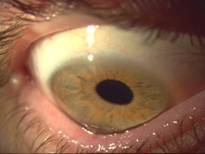 |
| Figure 3. Munson’s sign |
It was decided to try a piggy-back contact lens system to improve comfort and lens centration. Different silicone hydrogel lenses were trialled as the carrier lens. These were trialled under the patient’s existing RGP lenses. Silicone hydrogel lenses with higher modulus displayed fluting, especially in the left eye where the condition was more advanced.
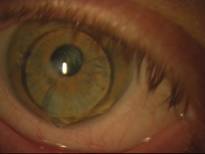 |
| Figure 4. Fluting |
An Acuvue OASYS lens was selected as the carrier for the right eye but the most comfortable carrier for the left eye was found to be a ‘traditional’ hydrogel lens (non- silicone hydrogel), presumably due to improved draping over the more distorted left cornea. Fluorescein was used to assess the fit of the lens combinations and this was useful in assessing the fluting.
 |
| Figure 5. Piggy-back lens system with fluorescein |
 |
| Figure 6. Piggy-back lens system |
Visual acuity was OD 6/9 OS 6/12 and the patient was pleased with the comfort, visual acuity and the improved wear times. The RGP lenses no longer decentre off the cornea. Interestingly he also appears to be less sensitive to light when the hydrogel carrier lenses are worn.
Discussion
These case reports have described the successful fitting of two RGP lens-intolerant keratoconic patients with silicone hydrogel piggy-back contact lens systems.
Lens comfort in keratoconus may be improved by the use of a hybrid lens design or a speciality soft contact lens. However, the relatively poor oxygen transmissibility of some of these lens types can lead to oedema-related ocular complications. Vascularisation of the cornea should be avoided in keratoconus, since vascularised corneas are less likely to be successful if keratoplasty is required in future. Piggy-back lens systems can be considered in such cases, and the high Dk lens materials currently available make this an attractive option that requires no additional expertise to fit than other forms of hydrogel and RGP lenses.
It is hoped that the prognosis for the two patients whose case reports are outlined here will be many years of comfortable contact lens wear, possibly avoiding the need for penetrating keratoplasty.
It should be borne in mind that ‘stiffer’ contact lenses (lenses with a higher modulus of elasticity) may not fit adequately in cases of moderate or advanced keratoconus because of the resultant fluting of the lens whereas thinner lenses with a lower modulus of elasticity may drape to the shape of the distorted cornea better, giving more centralised corneal coverage, better centration of the RGP piggy-back lens and better comfort.
Reference
O’Donnell C and Maldonado-Codina C. A Hyper Dk PiggyBack Contact Lens System for Keratoconus. Eye and Contact Lens 2004; 30 44-48
|